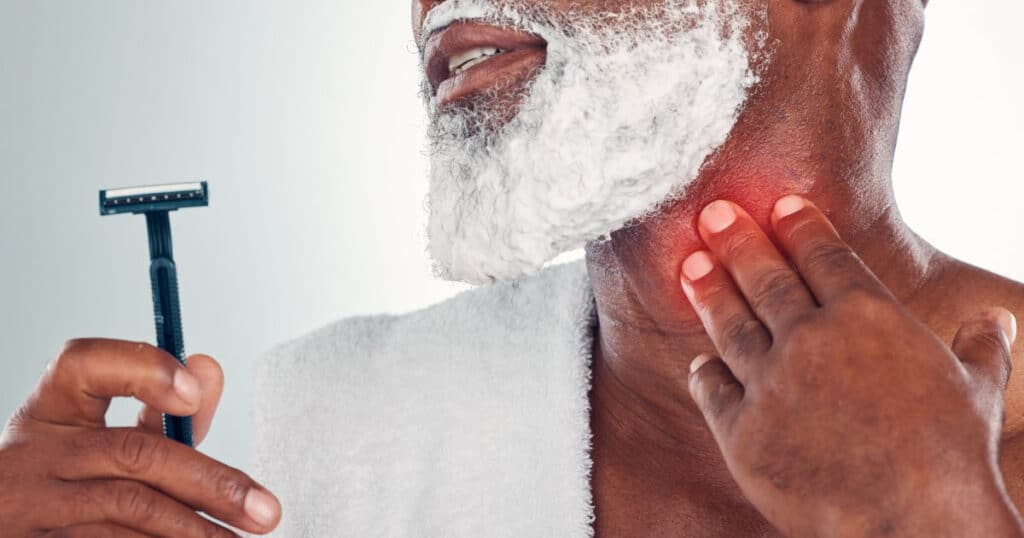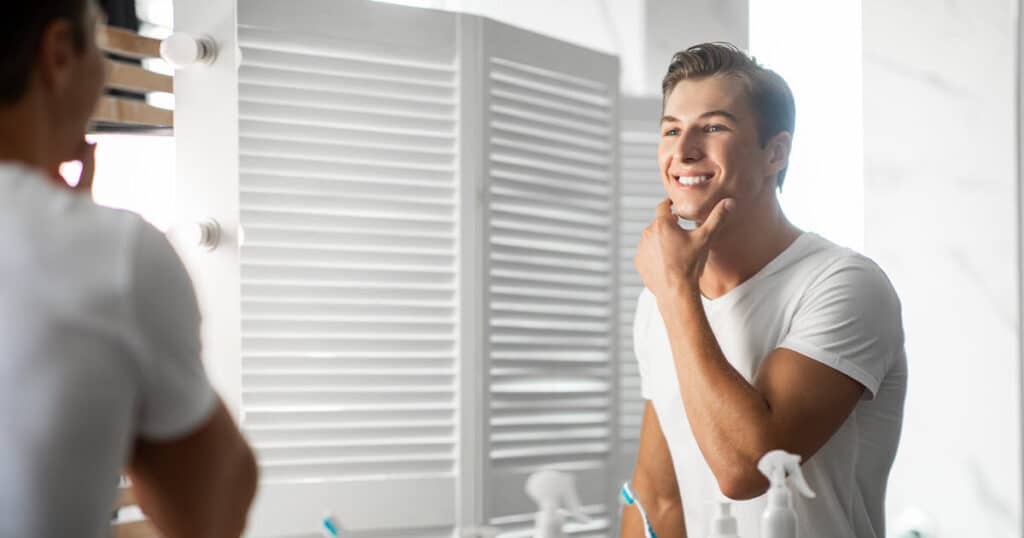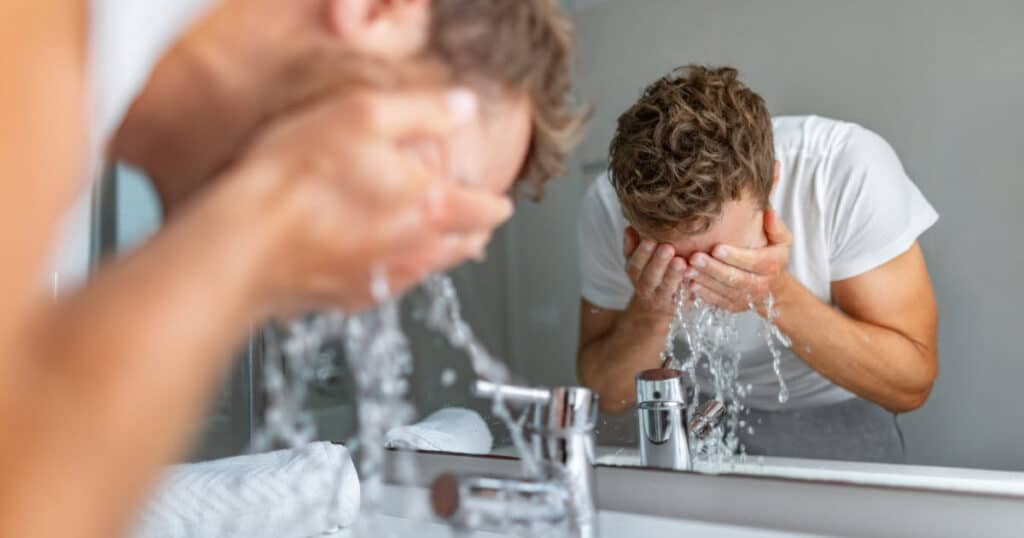In many of our posts, we discuss wet shaving: the shaving technique that uses safety razors or straight edge razors, all-natural soaps and creams, and soft shaving brushes. We’re fairly in love with it, and we’ve written a whole slew of posts about it. But what about dry shaving? There’s not as much content about dry shaving on the internet, and the content that has been written is a little lacking. And what IS dry shaving, anyway?
In this post, we’ll review the often-overlooked topic of shaving without soap, cream, or even water. We’ll discuss the equipment required, the pros and cons and the practice, and we’ll even take a look at the “wet shaving snobbery” that some dry shavers have to put up with.
First Things First: Let’s Define Some Terms
We’ll start with a definition of wet shaving, because as you’ll see, it’s important to define wet shaving to understanding dry shaving. Wet shaving, basically, is the use of safety blades or straight razor blades, along with all-natural creams and soaps to build a lather, to shape and/or remove facial hair. It’s a sensuous, luxurious, and inherently manly pursuit, and we’ve written endlessly about it, so click around if you’d like to read more.
But it’s kind of interesting: while people (mostly) agree on the definition of wet shaving, everyone has a slight different definition of dry shaving. Some men think it’s simply using a razor—safety, straight, or disposable—without any creams or soaps, and that might be the most “technically accurate” description. Perhaps the best example of this definition of dry shaving is taken from the 1987 Arnold Schwarzenegger classic, Predator:
That’s Mac, played by Bill Duke, and it may be the most significant dry shaving scene in all of Hollywood history, so enjoy it (and if you haven’t already seen Predator, you should). There are plenty of examples of men wet shaving in film—it seems like most episodes of Mad Men had at least one scene where Don Draper stands in front of a mirror with a classic Gilette safety razor—but to our knowledge, there’s only one example of dry shaving in film, and that’s it.
Other men, when discussing dry shaving, are referring to electric shavers, and that’s probably the most common usage of the term “dry shaving.” Electric shavers are incredibly popular, and millions upon millions of men use them every day.
Yet there are still other men who assert that “dry shaving” must be opposite to “wet shaving,” and if wet shaving involves safety razors and/or straight razors and all-natural soaps and creams, then “dry shaving” means shaving without safety razors and/or straight razors and without all-natural soaps and creams. In other words—shaving with a disposable razor and with shaving cream from a can, the way many men do.
We’ll go with all three definitions. “Dry shaving” isn’t really discussed as much as “wet shaving,” so whichever description does it for you—that’s the description of dry shaving.
Dry Shaving Gear and Equipment
The most common tool for dry shaving is the electric shaver. These typically come in two varieties—with rotary blades or with foil blades. Most rotary shavers have three circular shapes on the head of the shaver, adjust more easily to the different angles of the face, and look like this:

…whereas foil shavers are flat on top, and feature linear blades that travel back and forth beneath a metallic sheath on the head. They look like this:

Disposable blades, which you’re probably familiar with, and look like this:

and safety razors and straight razors, which look like this:

(The safety razor is the one of the left, and the straight razor is the one with the long wooden handle).
If you’re interested in dry shaving, you’ve got options.
Pros and Cons of Dry Shaving
Next up in our “What is Dry Shaving” post: advantages and disadvantages of dry shaving.
We’ll start with the benefits:
Dry Shaving: Pros
It Takes a Relatively Short Time. The biggest benefit of dry shaving is that it’s FAST. You need very little prep time—no changing blades in a safety razor, no stropping for a straight razor, and no whipping up a lather—and the shave itself is quicker. Most dry shaver complete a single pass and they’re out the door, and that saves time right there. Most wet shavers finish three full passes—one with the grain, with across the grain, and one against the grain—and that definitely adds some minutes to your morning routine.
If you’re pressed for time—that is, if you’re running late for work one day, or if you live a life in which you are consistently pressed for time—any spare minutes you can save are very valuable.
Dry Shaving is “Portable.” Wet shaving requires creams, soaps, new blades, and so on, whereas dry shaving simply… doesn’t. If you’re using an electric shaver, you need an electrical plug, which all houses, hotels, and locker rooms have (and there are plenty of electric shavers that are battery-operated, so you don’t even need a plug). If you’re dry shaving with a razor, all your need is that razor (and some water, to wash off your whiskers). That’s it—easy peasy!
That makes dry shaving a great option for traveling—if you’re on the road (or camping / hiking on the trail), you typically want to carry as little gear as possible, and dry shaving requires very little gear.
It Requires Less Space at Home. This is another one of those benefits that’s actually a comparison to wet shaving. Wet shaving takes up space on a counter-top, and for those of you who share a bathroom with roommates or a love interest, bathroom space is a commodity that you have to fight for. Dry shavers can swoop into any bathroom and get the job done without conflict. That’s an under-rated, and often overlooked, benefit of dry shaving.
Variable Whisker Lengths. Many electric shavers come with adjustable settings, so if you your whiskers to be 5mm or 10mm of whatever, you may have that option. If you like the unshaven / stubble look—and a lot of guys (and a lot of gals) LOVE that look—an electric shaver is a great tool.
And, there’s a corollary benefit to adjustable shavers—very often, you can use them on body hair, as well. Another nice feature.
Onto the cons. There are only two, but they’re something to think about:
Dry Shaving: Cons
Rashes, Rashes Everywhere. There are plenty of men who are able to dry shave, and their skin is fine. But there are a lot of men whose skin gets absolutely torn apart by dry shaving. Ingrown hairs and razor bumps galore.
There are a couple of different reasons for the irritation caused by dry shaving, and it’s usually a result of the type of dry shaving that’s performed. Electric shavers pull the hair up a little bit, so that they can clip the whisker at the root—that’s a process called hysteresis—and while it works well, a lot of men have an adverse reaction to it. Here’s what happens: the whisker is pulled up by the blade of the electric shaver, and the electric shaver cuts the whisker at the root. The whisker then retreats back into the skin, but it because the electric shaver pulled the whisker up out of the skin a little bit, the root of the whisker is now underneath the surface of the skin. When the whisker starts to grow again, it needs to break through the surface of the skin, and wallah—red bumps and irritation. Some guys don’t have that experience with electric shavers, but a lot of guys do.
And, if you’re using a regular disposable, or even a safety razor or a straight, it’s the lack of shaving cream or soap that damages the skin. Shaving isn’t a natural process—it’s something that humans do, and we don’t really need to—and it’s basically an assault on the skin. To lessen the damage from that assault, we prepare the skin by applying lathers that contain fats that protect the skin and healing agents that soothe the skin. Some guys are able to shave without preparing their skin with a lather, but for a lot of guys, shaving dry without a lather of cream or soap results is irritation and razor burn.
Quality of the Shave. We don’t often get to speak in absolutes, but we can say this with confidence: you will get better results when you wet shave. When it comes to actual whisker removal, three passes with a safety razor or straight razor is simply more effective than an electric shaver or a disposable.
If the main benefit of dry shaving is time, the trade-off is quality. Electric shavers aren’t designed to be as effective as straight razors and safety razors—they’re designed to be fast. They do, of course, remove whiskers, but they’re not as effective as straight razors or safety razors. There are many reasons to dry shave, but “extremely close shave” isn’t really one of them. And—for a lot of guys, particularly guys who like that 5 o’clock shadow look—that’s fine.
If you’re curious about our thoughts on the pros of wet shaving vs. the pros of dry shaving, we’ve written a more thorough investigation of issue, and you can find that here.
Some Helpful Tips When Dry Shaving
If you’re going to give dry shaving a shot, here’s some advice and “best practices.”
Change Your Blade Frequently. Shaving without lubrication on your face dulls a blade very quickly, and a dull blade will do a number on your skin. If you’re using an electric, invest in some replacement heads, and if you’re using a disposable, use it only a couple of times before tossing it and replacing it. You’ll save yourself a lot of facial irritation.
Give Yourself a Trim Before Your Start. If you’re dry shaving on longer whiskers, get out a pair of scissors, or use the adjust the settings on your electric. It’ll make dry shaving a LOT easier.
Go Easy. Many shavers—particularly new shavers—tend to use too much pressure when gliding over their skin with a disposable or electric. More pressure doesn’t really enhance your shave in any way, and actually increases your chances of nicks and cuts and irritation. A light touch is definitely better.
Find What You’re Looking For. If you choose to go with disposables, experiment with a variety of them until you find one you like. Most are inexpensive, but there’s a wide range of quality, and each one may feel different on your skin. Find one you like, that provides a close shave and no irritation.
Go with the Grain. This one is important: if you’re dry shaving, ALWAYS go with the grain of your whiskers, and never against or across them. Your shave won’t be as close, but you’ll experience a lot less skin irritation.
Switch It Up. Finally—don’t be afraid to make the jump! This may be the best advice we can give. If dry shaving works for you, that’s fantastic. Do your thing, brother. But if you find that you’re experiencing irritation, razor burn, or any other skin ailment, consider making the transition to wet shaving. It takes more time, to be sure, but you’ll save yourself a lot of agony—and you might even begin to enjoy shaving!
The Elephant in the Room: Wet Shaving Snobbery
For men who reaaaaaally like wet shaving—that is, traditional shaving with straight razors and safety razors—there’s a lot of snobbery when it comes to dry shaving. As a general rule of thumb, people who love wet shaving really look down on dry shaving.
But—and we’re committing minor blasphemy in the wet shaving community but writing this—that’s really unfair to dry shavers.
There are plenty of men who have tried wet shaving, and it wasn’t for them. Granted, those men be few and far between, as wet shaving seems to be implicitly enjoyable, but those guys are out there. They may not like the ceremonial aspect of it, or they may be irritated by having to slow down and take multiple passes on their skin, or they may simply dislike using razors that are as sharp as safeties and straights. And—if wet shaving doesn’t do it for them, who are we to judge? We’re ardent subscribers to the philosophy of “to each, his own.” If you prefer dry shaving, do your thing, man. We’re here to support everybody.
But—there’s another reason wet shaving snobbery is inappropriate: some guys simply don’t have time to wet shave in the morning. Let’s face it: life is really hard for a lot of people, and wet shaving is—as we’ve mentioned dozens of times—luxurious. In other words, it’s a luxury. It’s an indulgence, and not a necessity. As we mentioned above, the main benefit of dry shaving is speed. If you’re pressed for time—and there are a lot of dads out there who race to work at breakneck speed and then race home in order to spend time with their families—shaving is one of the activities you’re going to do as quickly as possible (and how many times have you seen a guy in the car next to you, shaving with a rotary on his way to work? Chances are, you’ve seen that a lot). It would be really, really lame of us to say that a man who’s rushed for time and wants to spend time with his family should be wet shaving instead of dry shaving.
Not only that, but there are also a lot of guys out there who are living on a brutally shoe-string budget, and high-end shaving supplies aren’t an option. Heck, that probably describes a lot of us. Even though wet shaving is actually a lot less expensive in the long run, a lot of guys don’t have the extra funds to buy the initial gear: razor, all-natural cream or soap, shaving bowl, stand, etc. That’s understandable, and wet shavers tend to overlook that.
So, if you’re a wet shaver who’s spite-reading this post and looking down on dry shavers, relax a little bit. To each, his own!
Summary / Final Thoughts
That’s it for our “What is Dry Shaving?” post! Hopefully we’ve shed some light on the topic. As we mentioned, there really isn’t that much material online about dry shaving, so if you’ve some info or tips you’d like to share, feel free to leave a comment below. Thanks, and be good!
Michael Morris is the head writer here at Rough and Tumble Gentleman. He's got a ducktail beard and loves Brazilian jiu-jitsu. He's married to the woman of his dreams and lives in Brooklyn, NY.




